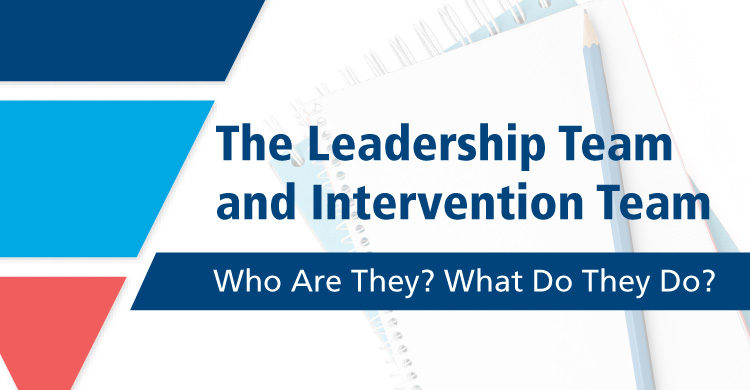Based on Best Practices at Tier 3, Elementary
“Can you help us? We have been to a lot of training sessions, and we think we know what needs to be done to implement RTI, but we’re not sure what the leadership and the intervention teams are supposed to do and who should be on these teams. Are they sounding boards, or do they actually make decisions?”
“Should the leadership and intervention teams make changes to the master schedules, ask people to attend meetings, or address schoolwide behavior?”
“We know where we want to go, but we’re not sure how to get there with the leadership and intervention teams.”
We hear these questions and concerns often as we work in schools across the United States. It represents what happens when principals and teachers don’t fully understand the roles and responsibilities of schoolwide leadership or intervention teams. There is a definite lack of clarity regarding the role, responsibility, and authority that comes with these two critical teams.
In researching and writing our book, Best Practices at Tier 3, Elementary, we became convinced that many of the struggles that were experienced by schools came from weaknesses in the formation and operation of both the leadership team (LT) and intervention team (IT). Often, we found members of these teams who could not explain their purpose, role, or responsibilities within the decision-making processes of designing and implementing both the PLC and RTI structures.
Buffum et al. (2018) summed it up best by recognizing the need for clarity as to the roles and responsibilities of the leadership and intervention teams: “Unless the right team leads the RTI process—a team that focuses its efforts on the right work—the anxiety and inevitable obstacles inherent in this level of change will overwhelm the best organization’s intentions” (p. 36).
Buffum et al. (2018) continue, “We recommend that the school’s leadership team serve as the site’s guiding coalition. Because of this recommendation, we use two terms—(1) leadership team and (2) guiding coalition—which are interchangeable. To achieve this goal, many schools need to redesign or repurpose their existing leadership team, as we find that most site leadership teams rarely function as a guiding coalition dedicated to ensuring high levels of learning for all students” (p. 36).
As a foundational point, members of the LT and IT must believe and be committed to the premise that every staff member must bear responsibility for all students’ learning. Without the teams’ unified voices of commitment to ensuring that all students can and will learn at high levels, there will never be the collective responsibility and accountability that motivates all staff to seek solutions when a student is struggling and needs support to learn.
It is the role of the LT to ensure that RTI is effective at all tiers, while the IT assumes the essential role of diagnosing and problem-solving at Tier 3. The interrelated relationship of these two teams must signal to all members of the staff that they believe it is their responsibility to openly collaborate to ensure the success of the total RTI system at all tiers.
The LT and IT must work hand in hand to implement the structures and processes necessary for a high-functioning system of interventions; this is never more true than at Tier 3. The two teams have a common goal, but their roles and responsibilities are different. The LT is responsible for ensuring that all the organizational structures are in place so the IT can be effective. The IT is the problem-solving team. The IT’s two primary areas of consideration are: (1) identifying and determining targeted needs and (2) prioritizing and ensuring intervention intensity. The planning, communication, and coordination necessary between the LT and IT must always strive to function seamlessly.
Forming an Effective LT
“Forming a powerful guiding coalition (LT) starts with identifying the true leaders” in your school (Frampton et al., 2010, p. 56). This includes formal leaders—those in key power positions in the school—and informal leaders—those recognized for their leadership, credibility, and influence in all sites and departments.
The LT “then grows over time as respected, reputable individuals with the capacity to lead from various sectors within the community are identified. Finding the right blend of strengths and interests pays great dividends toward future success” (Frampton et al., 2010, p. 56).
In forming the first LT, the principal should work to select members who exemplify a commitment to guaranteeing systems that ensure learning at high levels for all students. The LT should be representative of the teams from across the campus. Keep the following points in mind during the selection process.
Consider those who have the following attributes as potential members of the LT.
- Credibility: Those who have developed a reciprocal trust with others on the staff. Others look to them for candor and openness.
- Expertise: Staff members who have significant background in literacy, assessment, differentiation, instruction, and instructional systems.
- Influence: Staff members who are in leadership roles (formal or informal) within their grade level or department.
- Position power: Those who may control a program, lab, budget, or department that is, or could be, a major resource to the school.
- Avoid inviting those who may see participation as a stepping-stone to getting administrative positions or gaining power.
- hyInvite those who listen well, give frank and honest observations, and have students’ best interests at heart.
Attention should be paid to “maintain an appropriate balance of those with experience in the coalition and those who will infuse fresh perspectives” in expanding the guiding coalition (Frampton et al., 2010, p. 57).
It is essential that, when being asked to be a prospective member of the LT, the individual clearly understands the LT’s purpose and the role they would play on this team.
The LT’s membership size should allow members to have constructive discussions—too large and the LT meetings become nothing more than informational gatherings; too small and the coalition may not give a realistic picture of the district’s efforts. The team’s size must allow for the agility to make and implement decisions in a timely manner based on learning data and best practices. The team cannot take six months to come to a decision that impacts student learning. The team must be diligent and agile in conducting its work.
The Role of the Leadership Team (LT)
The LT must take explicit schoolwide actions and work collaboratively to build consensus and commitment for the school’s mission, vision, and work to put into place collective responsibility by all on the staff.
- Create a master schedule that provides sufficient time for team collaboration, core instruction, supplemental interventions, and intensive interventions.
- Coordinate and seek schoolwide human resources to best support core instruction and interventions.
- Allocate the school’s fiscal resources to best support core instruction and interventions, including school categorical funding.
- Assist with articulating essential learning outcomes across grade levels and subjects.
- Ensure all students have access to grade-level core instruction.
- Lead the school’s universal screening efforts.
- Lead the school’s efforts for schoolwide behavior expectations, including attendance policies and awards and recognitions.
- Ensure that sufficient, effective resources are available to provide Tier 2 interventions for students in need of supplemental support in motivation, attendance, and behavior.
- Identify students who need intensive support at Tier 3.
- Create a dynamic problem-solving or site IT.
- Prioritize all available resources to meet students’ needs with the greatest challenges in the areas of the universal skills of reading, writing, number sense, English language, motivation, attendance, and behavior.
- Continually monitor schoolwide evidence of student learning.
- Create a systematic process for referring students to the site IT.
- Assess intervention effectiveness. The structures and processes established by the LT are critical to the success of the IT in meeting the needs of students at Tier 3. These two teams have interrelated responsibilities for the implementation and success of Tier 3 intensive intervention.
The Role of the Intervention Team (IT) at Tier 3
The primary role of this team is diagnosing and prioritizing Tier 3 interventions. Team members utilize the structures put in place by the LT, such as meeting times, the talents of varied team members, as well as the various assessments utilized at Tiers 1 and 2 to diagnose and treat student needs at Tier 3. Actions that this team must undertake include:
- Utilizing all pertinent assessment information to determine the reason a student is not progressing in mastering foundational learning (reading, writing, comprehending and speaking the English language or the primary language of the school, essential academic and social behavior, and health and home)
- Determining the targeted interventions needed to accelerate learning for students in the targeted areas of need
- Ensuring the proper intervention intensity
- Monitoring student progress and adjust interventions as needed
- Utilizing a problem-solving, solution-oriented approach to addressing student needs
- Determining if students require special education. In order to perform these duties, given the wide variety of issues that students with significant gaps in learning present, team members should have varied expertise and the passion to work with persistence to serve those students with the greatest academic and behavioral challenges.
Team members must understand that they will face many obstacles in finding solutions for students who have been unsuccessful with current instructional methods. The students needing their support are frequently multiple years behind their peers in foundational academic or essential behavior skills. This team must be composed of problem solvers who work with determination to succeed. They must not be afraid to reach out for additional expertise or learn new strategies.
Their job is to find the reason a student is not progressing and then determine the targeted interventions to accelerate their learning. They must be open to the reality that they will need to frequently change and adjust the time, intensity, or type of intervention.
Small Schools with Hybrid Leadership and Intervention Teams
Determining the membership of the IT becomes an issue for many small schools, due to the limited number of staff. There are often not enough staff members to have a LT and an IT with separate team members. There are two possible solutions that we have seen as pragmatic, successful answers to this common problem.
1. The IT is a committee or taskforce of the LT
In this case, a limited number of the LT members (principal and three to five staff members) meet as a subcommittee of the overall LT. This group serves as the intervention problem-solving team and reports back to the LT as a regular component of the LT meetings. The overall LT provides the support and structure to ensure that the work of the IT is understood and successful.
2. The LT does double duty
In this scenario, the LT meetings have a two-part agenda. During the first part, the LT meets to review progress on team goals and set follow-up actions on the schoolwide implementation of RTI for academics and behavior, as well as identify students needing intensive support. During the second part, the team moves into a problem-solving and progress-monitoring approach with students identified as needing Tier 3 interventions. This approach utilizes the same people for both teams but requires two-part meetings and a commitment to address all the requirements of the leadership and ITs.
Leading from Compliance to Ownership
To build a comprehensive RTI system, the leadership and IT must be the standard-bearers of the school’s shared vision, the critical components for PLC and RTI implementation; and the goals, structures, and operations must be visible to all throughout the school.
These components form the foundation for the work with students. The members of these two critical teams must strive to turn the vision of the school into reality. Their efforts have a direct impact on the school’s commitment and ownership of learning for all students. A school’s staff will strive to implement at deeper and more successful levels when they see implementation being led—not as a matter of compliance, but one of ownership.
References:
Buffum, A., Mattos, M., & Malone, J. (2018). Taking Action: A Handbook for RTI at Work. Bloomington, IN: Solution Tree Press.
Frampton, S., Gil, H., Guastello, S., Kinsey, J., Boudreau-Scott, D., Lepore, M., et al. (2010). Long-Term Care Improvement Guide. Derby, CT: Planetree.
[author_bio id=”406″]
[author_bio id=”315″]







